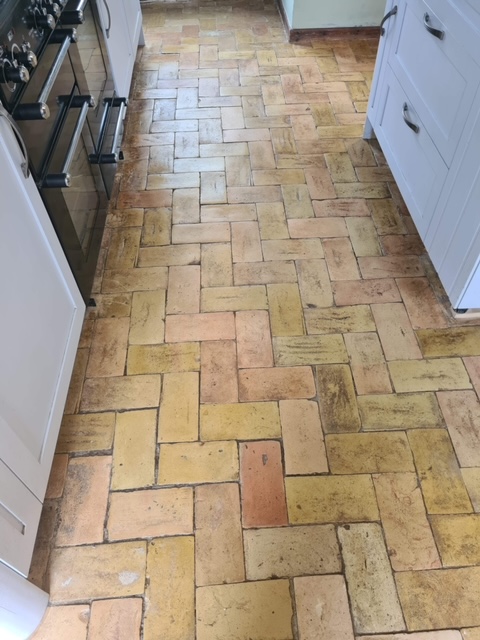I was recently asked to renovate this Brick tiled floor installed in the kitchen of an older property in the small hamlet of Edwardstone near Sudbury. It had been some time since the floor was professionally cleaned and the brick tiles were deeply ingrained with dirt and looking very dirty and dull. The owner of the property was finding it difficult to keep the floor clean and had decided it was time to call in some help.

I visited the property to survey the floor and it was clear to me that any sealer that once protected the floor was no longer working and dirt was being trapped in the pores of the brick. Whilst there, I also noticed there was no evidence of a damp proof course being installed and given the age of the property it was unlikely the floor had a damp proof membrane either and had probably been laid directly onto the soil.

Without a barrier between the bricks and the soil, efflorescence issues would be a distinct possibility. This is where alkaline salts from the soil rise through the floor and as the moisture evaporates the floor is left with white deposits on the tile, it would also mean I would need to use a fully breathable sealer to allow this to happen, anything else would results in moisture being trapped under the floor where it would reach out to the walls resulting in rising damp.
Cleaning a Brick Tiled Kitchen Floor
I didn’t want to increase the moisture levels in the floor by using lots of water during the cleaning process, so I opted to use a low moisture method that involved Tile Doctor Acid Gel. Being a gel cleaner, it is easier to manage the acid in the product and will also neutralise any alkaline salt issues.
The gel was worked into the tiles and grout using a special carborundum pad, fitted to our new Hyper Grinder rotary machine. This process removed any remnants of the original sealer and the dirt from the floor, four litres of Tile Doctor Acid Gel was used during the process. The floor was given a minimal rinse with fresh water to assist in the removal of the now soiled Tile Doctor Acid Gel and a wet vacuum was used to extract the soiling and dry the floor.
Sealing a Brick Tiled Kitchen Floor
The now clean floor was then left to dry overnight and on the 2nd day we tested it was dry using a damp meter. All was well so the Brick floor was sealed with five coats of Tile Doctor Seal & Go Extra, 2 litres were used in total. It is worth pointing out that Tile Doctor Seal and Go Extra is a breathable sealer that will allow moisture to rise through the brick.

The process went very well, and the floor is now cleaner and has a nice, easy to maintain sheen. For aftercare cleaning I recommended the use of Tile Doctor Neutral Tile Cleaner which is a mild, neutral ph cleaner. We recommend this as many of the products you find in supermarkets are simply too strong and bleach based which will slowly strip off the sealer and allow dirt back into the floor.

Source: Professional Restoration of a Brick Tiled Kitchen Floor in Suffolk